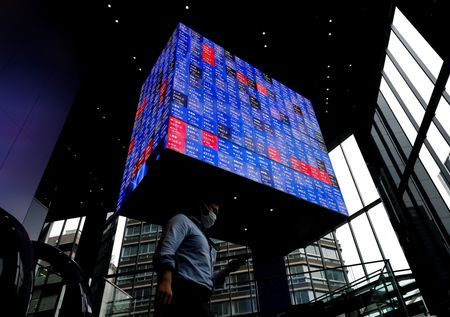
By Wayne Cole and Amanda Cooper
LONDON/SYDNEY (Reuters) – The dollar weathered another suspected blast of Japanese intervention to rise against the yen on Monday, while European markets got a lift from hopes that U.S. interest rates could rise more slowly than previously thought.
The dollar roared to 149.70 yen in early trade before hastily retreating to 145.28 in a matter of minutes in what traders and analysts said appeared to be at the hands of the Bank of Japan. It was last down almost 1% at 149.24.
The Financial Times reported the BOJ may have sold at least $30 billion on Friday to try to protect the yen from yet more weakness, which has sharply lifted the cost of Japan’s imports, particularly for resources.
Japanese authorities again declined to confirm whether they had intervened, but the price action suggested they had.
Any action to support the yen runs counter to the BOJ’s commitment to controlling Japanese government borrowing costs and could increase the pressure on it to step back on yield curve control at its policy meeting this week.
Sterling, meanwhile, see-sawed in volatile trade on news Boris Johnson had dropped out of the running for British prime minister.
Former finance minister Rishi Sunak, who is the market’s preferred candidate, has emerged as the front-runner for the job, which could reduce some of the political uncertainty hanging over the pound.
The news initially saw sterling jump almost a cent to $1.1402, but it could not hold and was last trading at $1.1328 as investors waited for more clarity on the contest. The leadership could potentially be settled later on Monday if Sunak becomes the only candidate to secure the minimum number of MPs’ votes required to progress.
“The day-to-day is tricky. My favourite expression on all of it this morning is this is a time to be a poker player, not a chess player. It’s all about positioning and sentiment and understanding who you’re playing against,” Societe Generale strategist Kit Juckes said.
Equities mostly extended the bounce that began late in New York on Friday on talk the Federal Reserve was debating when to slow the pace of hikes and might signal a step back at its November meeting.
Markets are still priced for a rise of 75 basis points next month, but have scaled back bets on a matching move in December. The peak for rates has also edged down to around 4.87%, from above 5% early last week.
ECB, BoC SET TO HIKE
Stocks in Europe opened on an upbeat note, with the STOXX 600 up 0.7% on the day, ahead of a week of packed earnings, as 118 companies, including big guns like HSBC, Unilever and TotalEnergies are set to report.
Chinese blue chips slid almost 3%, while the offshore yuan hit another record low against the dollar after Xi Jinping secured a precedent-breaking third leadership term, picking a top governing body stacked with loyalists. Xi is likely to stick to his zero-COVID policy that is damaging growth, analysts say.
Delayed data on gross domestic product(GDP) showed the Chinese economy grew 3.9% in the third quarter, above forecasts for 3.5%, but retail sales disappointed, with a rise of 2.5%.
Markets now await figures on U.S. GDP due on Thursday and core inflation measures the day after. The economy is forecast to have grown an annualised 2.1% in the third quarter, while the Atlanta Fed GDP Now indicator rose to 2.9% in the latest week, from 2.8%.
Sentiment will also be tested by some major earnings with Apple, Microsoft, Google-parent Alphabet and Amazon all reporting.
The European Central Bank meets this week and is widely expected to raise its rates by 75 basis points, though it is less clear whether it will signal a further such move in December.
“Although we do not expect any ‘dovish’ policy signal, we maintain a bias towards a lower rate path than currently priced by markets,” said analysts at NatWest Markets in a note.
“We forecast +50bp in December and +25bp in early 2023 to a 2.25% peak,” they added. “There is more uncertainty around QT (quantitative tightening), where beginning sales in Q1 2023 could well be announced.”
The euro was off a fraction at $0.9835, having briefly been as high as $0.9899 early in the session.
The Bank of Canada is also expected to tighten by 75 basis pointsat its meeting this week.
The possibility of a slowdown in U.S. rate increases helped bonds pare some of their recent heavy losses, with U.S. 10-year Treasury yields easing to 4.16% compared to a 15-year peak of 4.337% on Friday. [US/]
In commodity markets, gold was sidelined at $1,654 an ounce. [GOL/]
Oil prices surrendered early gains following soft data on Chinese demand. Brent retreated 42 cents to $93.08 a barrel, while U.S. crude fell 41 cents to $84.64. [O/R]
(Reporting by Wayne Cole; Editing by Jacqueline Wong, Christopher Cushing and Susan Fenton)

